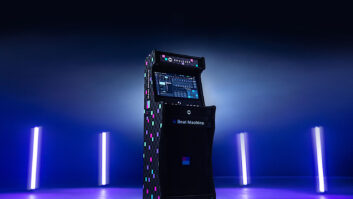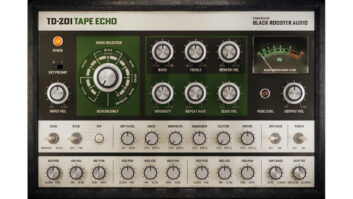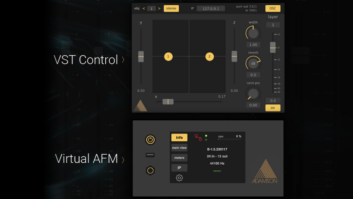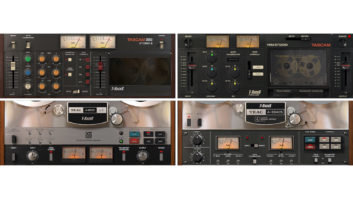Despite an almost endless variety of higher-performance disk and tape formats available in the market, the ubiquitous 16-bit, 44.1/48kHz DAT format is far from dead. Yet at the same time, I feel pretty safe predicting that no new DAT recorders will be presented at any trade shows, this year or ever.
Historically, attempts to expand DAT’s horizons have been limited to 24 bits at the “standard” sample rates (as with the Tascam DA-45) or doubled (88/96kHz) rates at the “standard” bit depth, with the Pioneer/HHB 9601 being the sole example. Unfortunately, we can’t have our high-sample-rate cake and eat those tasty wide dynamic-range bits at the same time, due to the lack of real estate on tape. Increasing tape speed to four-times normal reduces a 120-minute DAT to a half hour. Four-hour (120 meter) data DAT tapes are in the wings ready to save the day, but few tape transports can reliably move such thin tape. Such a Full-Monty format change would probably require extensive mechanical redesigns as well…
Since we’ll be dealing with the DATs for some time, I’d like to offer my flu shot for some of the bugs that plague two popular timecode DAT machines, the Tascam DA-60 and the Sony PCM-7030, with a little trickle-down to some of the more “common” recorders. In this and future articles, some of the projects will be DIY-I very much encourage users to pop the cover and get familiar with what is “normal.” other “nonuser-serviceable” tips are FYI. It’s better to know what’s coming than get caught with your pants down, or skirt up, eh? (You can always pass along these tips to your favorite technician.)
ECoNoMY oF SCALEWith the exception of the Fostex D-15, timecode DAT decks are priced well above their “timeless” cousins. Ironically, timecode-equipped 8-channel MDMs-such as Tascam’s DA-98 and the Alesis M20-are more affordable than many timecode DAT machines. Why? The selling price is directly related to demand and the economy of scale. More people need sync-able multitrack recorders than need TC DAT decks, hence the price disparity. And considering their higher price tag, TC DAT recorders are typically less user-friendly (lots of video-related features) and not necessarily more reliable, an annoyance that is compounded if the device in question sees infrequent use.
According to Brian Falatovich of Chicago’s Midwest Digital, “The best DAT machine ever made (not considering its digital converters) was the now-discontinued Sony PCM-7030.” This can be confirmed by taking a peek under the hood, especially if you are familiar with other DAT decks. While most pro DATs are genetically modified consumer models, nearly everything about the PCM-7030 suggests that knowledgeable pros put great thought into developing its extensive feature set. Compared to the PCM-2500, the PCM-7030 is quite serviceable even with its many circuit boards. Notice I said “nearly,” because this machine shares a few common flaws with many of Sony’s less-endowed children.
oNE oLD WIVES’ TALEIt is a widespread rumor that Sony and Panasonic DAT decks are not aligned to the same standard. Both companies specify their own test tapes; they differ in terms of approach, yet yield the same end result. Panasonic’s consumer-based transports hold an alignment better than most of Sony’s more professional mechanisms, a disparity that is easily remedied by a skilled technician. The illustration Fig. 1A and photo Fig. 1B detail the “slant block,” the assembly that unloads the tape from the shell and precisely guides it around the head-drum. This part is responsible for the compatibility myth.
The slant block is so called because it consists of an angled post that positions the tape to match the head assembly, which is not “square” with the deck plate. other key components include a precision stainless-steel tape guide with a roller made from ceramic, stainless steel or plastic. The guide and its mate-a machined brass insert-have extremely fine threads to allow precise vertical alignment.
once in the ballpark, less than one-eighth of a turn in either direction will make a major difference in the output of the RF envelope (the signal from tape) when using the test tape. In reality, the system is very tolerant of typical machine-to-machine variations. once the tape path is optimized, a locking screw secures the adjustment.
The fly in the ointment is that the brass insert is merely press-fit into the base of the slant block. After repeated load and unload cycles, the two parts no longer behave “as one,” causing the alignment to change every time a new tape is inserted. Sony’s new parts are no better than the originals. Remarrying the old parts with epoxy (after degreasing) has so far yielded a 100% success rate.
CLIMBING THE ALPSTascam’s TC DAT decks are more affordable than Sony’s, so the former find their way into many audio facilities while the latter are more common in video houses. All of Tascam’s DAT transports are made by Alps, an original equipment manufacturer (oEM) that supplies the mechanisms found in the otari DTR-90, the Fostex PD-2 (portable) and D-30 (rackmount) TC DAT recorders. By some stroke of luck-or genius-Fostex bypassed the problematic front-loading “elevator,” opting instead for a simple, trouble-free hinged loading door. (Sony, Panasonic and Pioneer make their own DAT transports. The Fostex D-5 and Tascam DA-20 are entirely made by Pioneer. The transport in those machines found its way into the Fostex D-15 and PD-4 as well.)
The Alps loading mechanism is a little too delicate for impatient Americans who are accustomed to slamming VHS tapes into their home VCRs. Cassettes not gently inserted will easily bend metal parts, pushing electromechanical tolerances beyond the machine’s ability to compensate.
Four common symptoms plague the Alps front-loading mechanism: It can either be sluggish or too hungry during feeding, the latter being least desirable. on a good day, a cassette sucked in before being securely engaged will be ejected. (on a bad day, the machine will jam.) During the unload process, the “Central Scrutinizer” may not sense that the tape is fully ejected, causing an endless “deja` vu” of load and unload. To spare you some mental anguish, the fourth symptom is described below, under the heading, “The Claw.”
SPRING INTo ACTIoNThree sensing switches are hidden on the underside of the DA-60’s right “junction” PCB as shown in the upper half of Fig. 2. (The lower portion of this figure shows the visible side of this PCB.) No adjustments are provided, and initial attempts at creating an adjustment “window” yielded mixed results. As mechanical friction seems inconsistent among the various mechanisms, a more basic “fix,” shown in Fig. 3, involves adding a spring that serves a double purpose. As the cassette is loaded, the spring creates resistance so that the tape is fully engaged before tripping the sensor switch. on the return trip, the spring ensures that the mechanism returns to the same “at rest” position, positively disengaging the switch.
Note: Under normal conditions, the job of the capstan motor is to maintain exact speed. Alps also uses the capstan motor to power the loading mechanism! A series of reduction gears convert the relatively weak rotational energy into a force barely powerful enough to raise and lower the cassette. The design is far from elegant.
I searched high and low for the perfect spring, finally settling on the type used by Tascam for the loading drawer of the DA-30 and DA-30 MKII (part number 5801396801). Cut the spring in half, fold out the last coil so that it can be easily hooked and attach as shown in Fig. 3.
THE CLAWAll DAT shells have a rectangular slot designed to accept a claw that, when implemented, can assist in the positioning process. Fig. 4 shows the black plastic assembly on which the claw pivots (indicated by the yellow arrow). If users yank the tape before it is fully released, the claw will break. This DA-60 subassembly does not have a part number so it can not be replaced. Instead, it is necessary to purchase the entire loading mechanism (a $400 part).
ouch!After installing the spring, if the claw still doesn’t reliably disengage, the final tweak is to apply a slight bit of pressure to the “thrust and support” beam as indicated by the purple arrow in Fig. 5. This horizontal bar provides structural stability to the loading mechanism as well as “thrust” to trigger the claw’s release. Gently apply pressure and let go. Then load and unload a tape repeating the “pressure process” until the tape is consistently released.
END oF TAPEIn providing this information, it is not my intention to take away business either from myself or from my friendly competitors. Tape machine repair requires experience, patience, fine tools (in good condition), a steady hand, test equipment and test tapes, ample illumination, good vision and/or optical magnifiers. That said, an educated consumer is the best customer. Get to know what’s on the inside, be good to your gear, be happy on the outside and save a hug for your technician!







